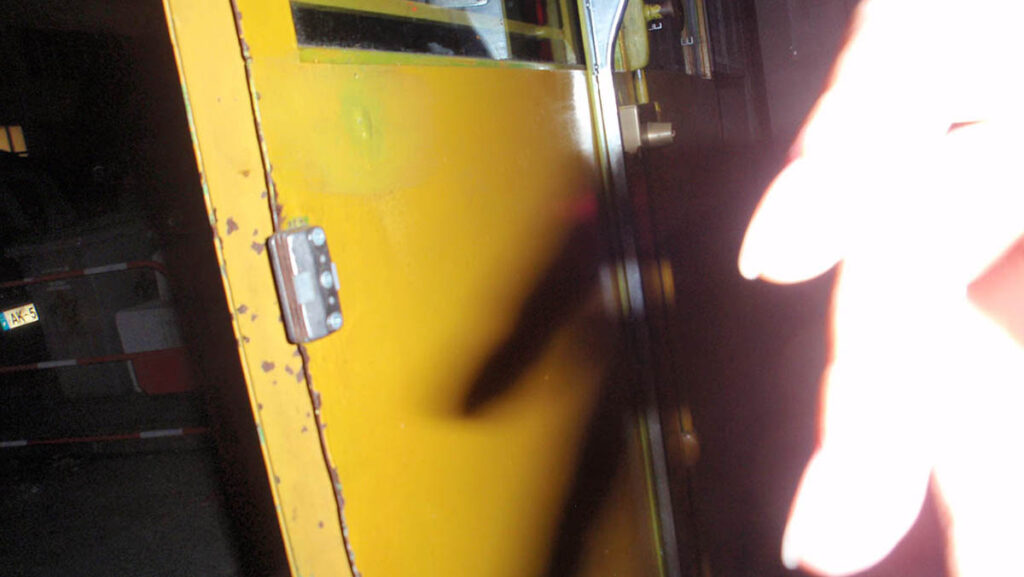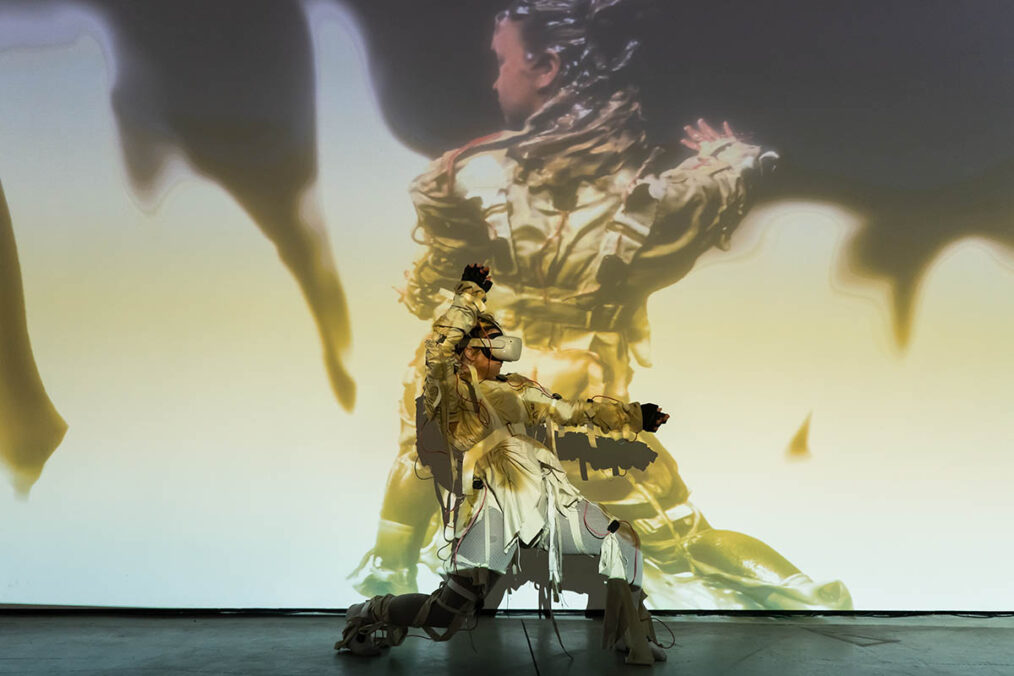
Hold to something if that makes you comfortable, like a drink, maybe have a sip from time to time. This text is here to assist you, can not replace your subjective experience. Fold it, take it home. Become your own avatar – be the glitch.
A dancer, absorbed in her thoughts and her movements, explores the space. She is just getting to know herself anew, distanced from the perceivers through VR glasses. Not only visible here, in the analog exhibition space, but simultaneously happening in a digital world. She was deconstructed, reborn as a 3D Avatar. Her journey is projected to the walls, the used technology in the room refers as a material proof of this process.
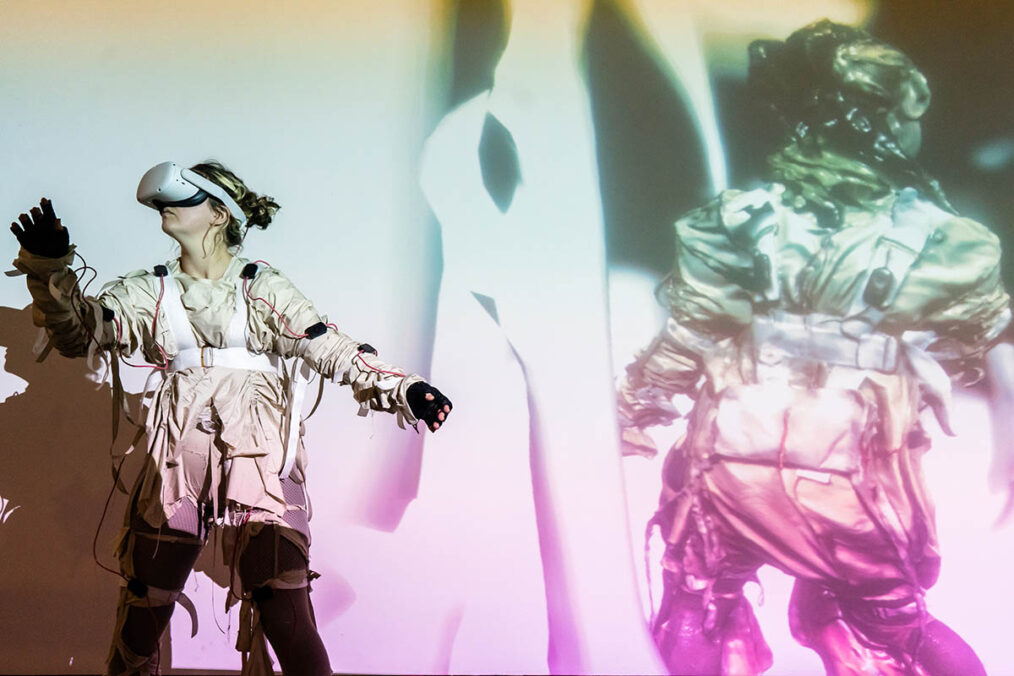
The performance was seen at FRANZ JOSEFS KAI 3 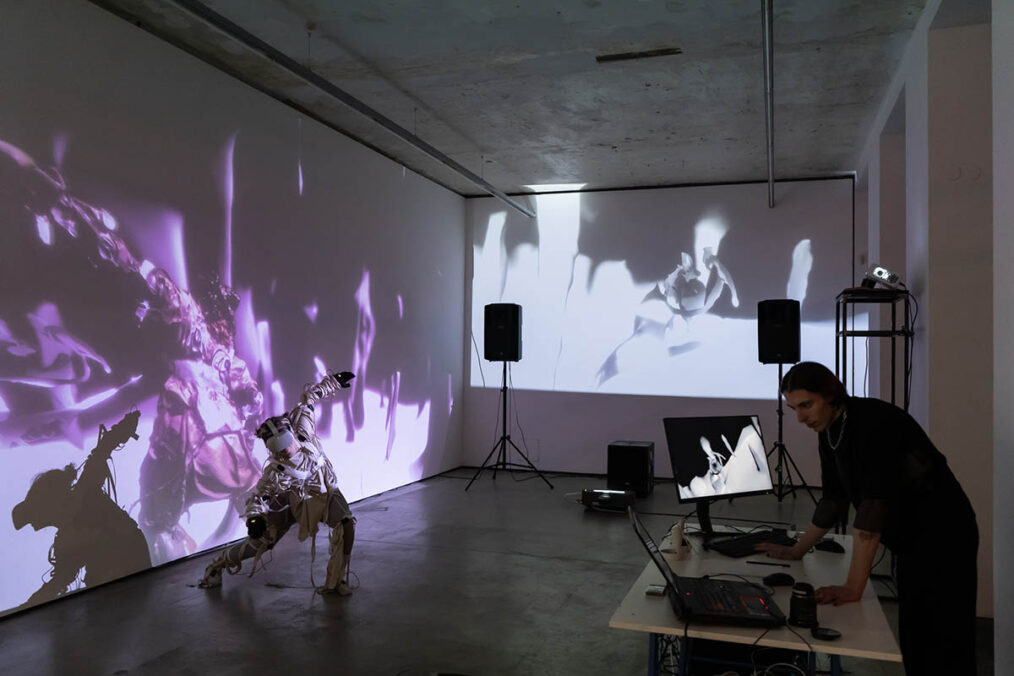
The performance was seen at FRANZ JOSEFS KAI 3
transreal, a collaboration project between the contemporary dancer Hannah Wimmer and the transmedia artist Maximilian Prag was born out of the artists´ desire to explore how movement and self-experience can be translated into a virtual environment. The costume by Anna Schall creates an interskin between the performer and Avatar and extends the motion capture technology, allowing for an in-depth exploration of the body and how it moves and interacts with both physical and virtual spaces. The sound set provided by MARAws accompanies the performance and embodies and aestheticizes the performative relations.
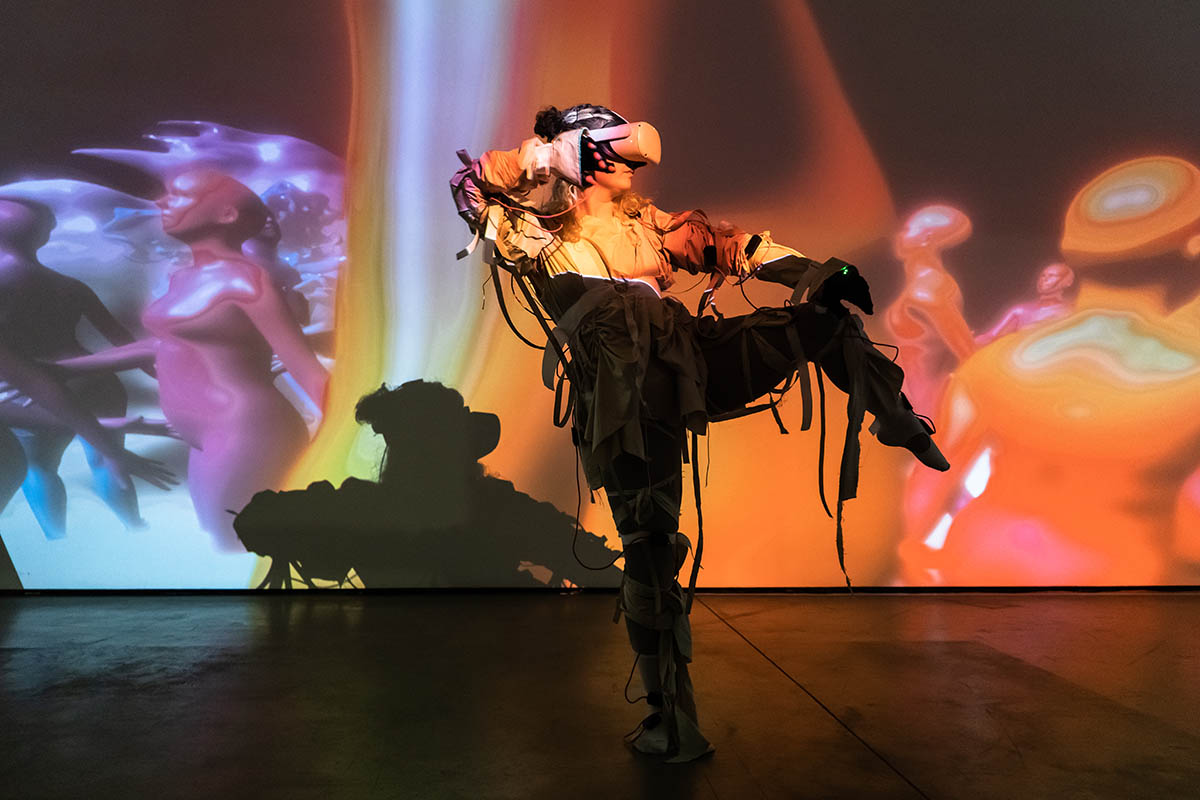
The artists` investigations of how the physical and virtual can co-exist simultaneously include ideas of author Legacy Russel. Her Manifesto Glitch Feminism is a key element of this performance, encouraging audiences to break down traditional ideas of gender and identity through the glitch (1) and explore how these concepts can be deconstructed and reimagined. By using the ‚body‘, we give material form to what has no form, an abstract assemblage. Taking advantage of both the real and virtual worlds, the contemporary self-body incorporates virtuality and transforms it into another manifestation. The title heralded as “transreal” a term created by Micha Cárdenas, is to describe the virtual in this exchange between realities (2). Through the virtual, we have the freedom to alter ourselves, becoming a “complex new expression of prosthetic reembodiment through which our physical bodies and subjectivities extend themselves into the virtual terrain.” as Legacy Russel states. It is a fragmented self-body that is born as a virtual artifact, but becomes tangible as physicality and perception. In their performance, the dancer glitched in both her virtual and physical self and was encoded in new life while being complexified through 3D Scanning techniques. Computers and devices become our invisible second selves, an extension to define our personal and cultural identity. We are asking ourselves the increasingly conscious question of how the Internet affects our current notions of identity and can grow beyond binaries and structures, becoming visible in our transreality. In the digital worlds, parallel identities can co-exist and we can recreate our personality parts as whole entities. Our identity becomes refracted and newly perceptible in the blurred transitions between the digital and physical. Although the performance is rooted in digital art practices, it differs from their traditional form in its complexity and interactivity. Unlike digital art that is often experienced solely through a screen, this performance allows us to perceive a live process, creating an immersive experience that blurs the boundaries of reality and sketching us a new interpretation of what bodies within a space can be.
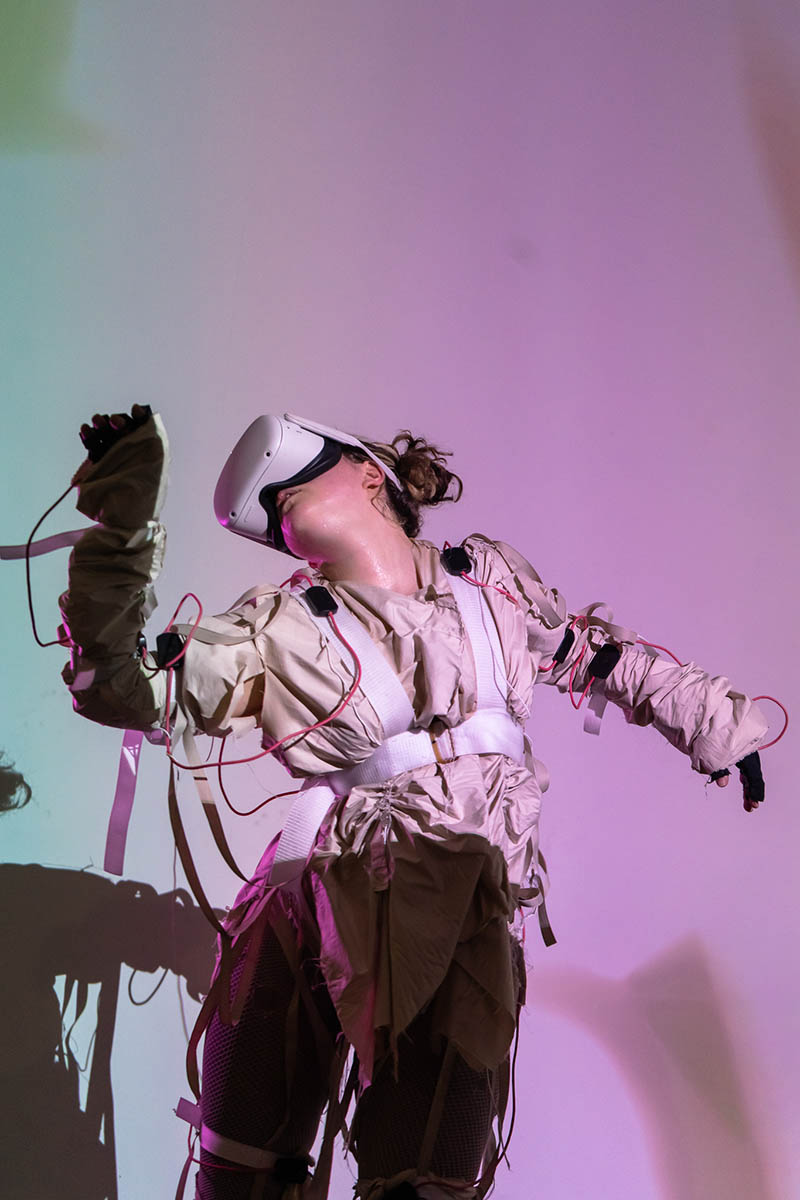
Hannah Wimmer is a contemporary dancer and choreographer currently based in Vienna. In her practice movement is used as a language to transform space, form connections and challenge ones perception and emotions. She draws inspirations from other art forms and has collaborated with different artists from all over the world. Her current interests within her work focus on feminist politics, queer theory and connected body and identity issues that can be addressed both in the physical as well as in the digital landscape. The body itself is always the main material and source of her practice and research but using props and other art forms to enhance and support the feeling of opening up and taking up space and therefore collaborative and collective work with other artists has become more and more in her artistic and performative endeavors. Hannah recently finished her MA degree in Expanded dance practice (Choreography and performance) at London Contemporary Dance School, validated by the University of Arts in London.
Maximilian Prag is an interdisciplinary artist and designer testing contemporary visual and new media culture. Working with new media technology in between visual communication and art, he creates new formats of digital representation, virtual worlds, digital generative imagery and multimedia installations. He is interested in contemporary imagery, internet culture and experimenting with phygital experiences exploring new interactions in between our mixed realities, online and away from screens. The collective work, community and collaborations are important parts of his artistic practice, always engaging in projects outside of his individual practice, from music videos, stage design, live visuals, virtual exhibition design or fashion design. Maximilian is working as a 3D designer for the Vienna-based media arts festival CIVA by sound:frame, which he accompanied from its inception and had an integral part in its conceptualization. He is currently studying Graphic Design and Transmedia Arts at the University of Applied Arts. Living and working in Vienna.
Performance: Hannah Wimmer & Maximilian Prag
Costume: Anna Schall
Music: MARAws
Text: Josepha Edbauer
Graphics: Maximilian Prag
The performance was seen at FRANZ JOSEFS KAI 3 on the 9th and 10th of February 2023.
(1) “A Glitch is an error, a mistake, a failure to function. Within technoloculture, a glitch is part of machinic anxiety, an indicator of something gone wrong. […] Within glitch feminism, we look at the notion of glitch-as-error with its genesis in the realm of the machinic and the digital and consider how it can be reapplied to inform the way we see the AFK world, shaping how we might participate in it toward greater agency for and by ourselves.” Legacy Russel, Glitch Feminism. A Manifesto, London/New York 2020, p.8-9.
(2) “The Transreal explores the use of multiple simultaneous realities as a medium in contemporary art, including mixed reality, augmented reality and alternate reality approaches. Building on the notion of „trans“ from transgender, signifying the crossing of boundaries, the author proposes that transreal aesthetics cross the boundaries created by a proliferation of conceptions of reality that occurred as a result of postmodern theory and emerging technologies.” Micha Cárdenas, The Transreal Political Aesthetics of Crossing Realities, Dresden/New York, 2012.




